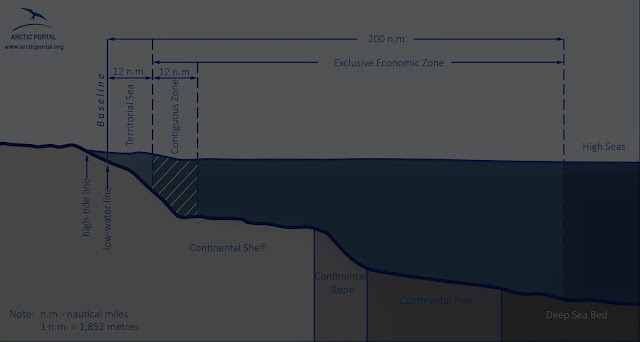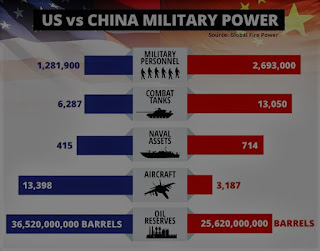- Get link
- X
- Other Apps
South China Sea (SCS) the intense or critical dispute which involve many South East Asian countries but most importantly it stretches two super power face to face, this clearly shows how significantly important the dispute is-Anyhow, firstly understand the dispute with reference to history then precisely discuss each thing with proper background. You can gauge the intensity of this conflict after reading this blog.
Geographical location of SCS:
It is located in South East Asia, south of China, east and south of Vietnam, west of Philippines and the north of the island of Borneo. The sea covers approximately 3,700,000 km² (1,350,000 sq mi), this is larger than the area of India. It is connected by the Taiwan Strait with the East China Sea and by the Luzon Strait with the Philippine Sea (both marginal seas of the Pacific Ocean).
What is the dispute?
Basically it is a territorial dispute which involve both island and maritime claims among several sovereign states within the region, namely China, Brunei, Taiwan, Indonesia, Malaysia, Philippines and Vietnam. The dispute include the island, reefs, banks and other features of the South China Sea, including the Spartly Islands, Parcel Islands, and Scarborough Shoal, geographically and potentially these islands has many salient features.
South East Asian states claim in this region is very complex because each states claim is different from the other, you can't imagine that no one's position matches each other's. Just understand through this picture that how each states claim is dissimilar.
History:
History matters a lot in order to understand the conflict,
just start with World War II, The Empire of Japan pre owned these islands for
various military purposes, at that time no one claimed these islands as their
own. After the War, Japan had to withdraw all its troops under an agreement
called “Treaty of Francisco” which is also known as Treaty of
Peace with Japan which, however, did not specify the new status of the islands.
The People's Republic of China made various claims to the islands during the
1951 treaty negotiations.
In 1947, Kuomintang government of the Republic of China officially
proposed an “Eleven Dash Line” concept which comprises more than 80% of South China Sea. Later on, the Communist Party of China took over
mainland China and formed the People's Republic of China in 1949, the line was
adopted and revised to “Nine Dash Line”, as endorsed by Zhou Enlai.
 |
| Eleven Dash Line |
 |
| Nine Dash Line |
- What is Exclusive Economic Zone?
EEZ is a sea zone prescribed by
the 1982 United Nations Convention on the Law of the Sea (UNCLOS) over which a state has special rights regarding the exploration and use of marine
resources, including energy production from water and wind. It stretches from
the baseline out to 200 nautical miles (nmi) which is around 370 kms from the
coast of the state in question.
According to UNCLOS, sovereign states has the right to do whatever they want in the restricted area which is defined by the law of sea. But China’s narrative is completely different, saying its rights go back centuries.
Importance of SCS:
Why SCS is surrounded full of controversy? Its prominence
resources and location make it complicated-How, about US 3.37 trillion worth of
global trade passed through the route annually, which accounts for a third of
the global maritime trade. Moreover, sea’s estimated 11 billion barrels of oil
and 190 trillion cubic feet of natural gas, make this region precious. Do you expect that with these resources there can be no complications? truly no.
If you look at China’s perspective, this route is consider to be the backbone of China’s economy or energy resources. About 80% of China’s energy imports and 39.5% of total trade passes through South China Sea. China’s major ports 3 out of 5 are located in South of China.
New Super Power:
A super power is a state which have all the resources which can change the world order or can challenge anyone. This is done through the combined means of economic, military, technological and cultural strength as well as diplomatic and soft power influence. Traditionally, superpowers are prominent among the great powers. United States is a current super power because of all above strength. But China globally is a bigger market, although it is not consider as a super power but as an emerging you can’t denied. Let’s compare some data.
- Economic Comparison:
United States and China are the two largest economies of the world. Both country together share 40.75% and 34.27% of total world's GDP in nominal and PPP terms, respectively in 2019. GDP of both country is higher than 3rd ranked country Japan (nominal) and India (PPP) by a huge margin. Therefore, only these two are in competition to become first. It took a while to cross US GDP but China’s future policy threatening the USA.
Due to vast population of China, more than 4 times of US's population, difference between these two country is very high in terms of per capita income. Per capita income of United States is 6.38 and 3.32 times greater than of China in nominal and PPP terms, respectively.
- Military Comparison:
Both the states have greater military power, just start with military budget of both the rival, US spend 610 billion$ which count of 3.1% of the GDP while China spend around 228 billion$ which is 1.9% of GDP. The picture clearly shows how powerful they are.
Remember that the above figure is not 100% efficient, just for consideration. You can clearly see the difference in naval asset despite the fact that US military is better than Chinese military but in terms of sea power USA is far away from China.
Why am I telling you all these things?
The above information is not directly related to SCS but indirectly it may, history witness that two major power never fought a war directly because doing so hurts them both a lot, on the contrary they damage others interest through proxies. US interest is crystal clear in this region, furthermore US also encourage other states including Australia to participate freedom of navigation operation in SCS, which may hurt China poorly.
The United States, which maintains important interest in ensuring freedom of navigation and securing sea lines of communication (SLOCs), has expressed support for an agreement on a binding code of conduct and other confidence-building measures. China's claim threaten SLOC's, which are important maritime passages that facilitate trade and the movement of naval forces.
According to UN Secretary of States Mike Pompeo “Any
[People's Republic of China] action to harass other states' fishing or
hydrocarbon development in these waters - or to carry out such activities
unilaterally - is unlawful,” he further said “The world will not allow Beijing
to treat the South China Sea as its maritime empire.” In respond to Mike Pompeo statement [The Chinese embassy in Washington DC said
the US state department "deliberately distorts the facts and international
law including the United Nations Convention on the Law of the Sea". It
said America "exaggerates the situation in the region and attempts to sow
discord between China and other littoral countries.
Conclusion:
The current status of the dispute is very critical, Beijing’s dominancy is clear in the region-military bases in Spartly or Parcel Island threatening the opponents. China also built artificial island which further enhance their strength. The US has long opposed China's actions but not called them illegal until now. But recent movement of US fleet or his allies in SCS clearly shows the intension of Washington, Japan sends three vessels to South China Sea in anti-submarine exercise on 10th Oct. This year USA, several time participate in FONOP’s in the disputed water. Australia also backed USA’s stance and strongly reject China’s maritime claim. The other major power playing a neutral part in this dispute. It’s very difficult to judge where this dispute end but it’s definitely clear that it would have consequences in global level.
China vs Philippines
China vs USA
Complex Issue
Indirect War
Naval War
Nine Dash Line
SCS dispute
SCS history
Sea War
South China Sea
South China Sea War
Strategic Interest
Territorial Issue
- Get link
- X
- Other Apps
Comments






Hm..MashaAllah....very informative blog.....May Allah (S.W.T) Bless you in Every Aspects of Life!
ReplyDeleteAmeen
Delete